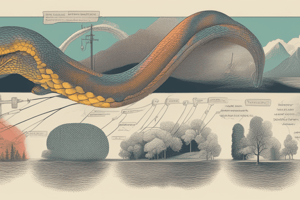Podcast
Questions and Answers
Which symbol is used to assign a value to a variable in Python?
Which symbol is used to assign a value to a variable in Python?
- :
- ==
- +
- = (correct)
What is the correct way to define a function in Python?
What is the correct way to define a function in Python?
- def function_name(): (correct)
- func name() {}
- define function() {}
- function function_name():
Which data type is used to store whole numbers in Python?
Which data type is used to store whole numbers in Python?
- Integer (correct)
- Float
- Boolean
- String
What is the correct way to declare a variable in Python?
What is the correct way to declare a variable in Python?
Which keyword is used for defining loops in Python?
Which keyword is used for defining loops in Python?
What is the purpose of a 'while' loop in Python?
What is the purpose of a 'while' loop in Python?
Which looping construct in Python iterates over each item in a collection?
Which looping construct in Python iterates over each item in a collection?
In Python, what is the purpose of conditional statements like 'if', 'elif', and 'else'?
In Python, what is the purpose of conditional statements like 'if', 'elif', and 'else'?
What does the following code snippet demonstrate: i = 0 while i < 10: print(i) i += 1?
What does the following code snippet demonstrate: i = 0 while i < 10: print(i) i += 1?
Why is Python considered an excellent choice for beginners?
Why is Python considered an excellent choice for beginners?
Flashcards are hidden until you start studying
Study Notes
Python for Beginners: Variables, Data Types, Functions, Loops, Control Flow
Python is a popular, versatile, and user-friendly programming language that is widely used in various fields, including web development, data analysis, machine learning, automated tasks, and more. While Python is typically praised for its simplicity and ease of use, understanding fundamental concepts such as variables, data types, functions, loops, and control flow is crucial for mastering the language.
Variables
A variable is a named location in computer memory where you can store values. It begins with a letter or underscore (_), followed by zero or more letters, numbers, or underscores. Variable names are case sensitive. In Python, you declare a variable without any special declaration statement. Just assign a value to a variable directly. For example:
x = 5
y = 10.67
name = "John"
Data Types
Python supports different types of data, including integers, strings, floating-point numbers, booleans, and others. These data types determine how data can be stored and processed in Python. Examples include:
## Integer
num = 10
## String
str = "Hello World!"
## Float
price = 99.99
## Boolean
bool = True
Functions
Functions are reusable pieces of code that perform a specific task. In Python, functions can be defined using the def keyword followed by the function name and parentheses. They can return values to be used in further computations. Here's an example:
def greet(name):
print("Hello", name)
greet("John")
Loops
Loops let you execute a piece of code repeatedly until certain conditions are met. Python includes two main looping constructs: while and for. The while loop runs as long as the specified condition remains true, while the for loop iterates over each item in a collection. Examples:
## While loop
i = 0
while i < 10:
print(i)
i += 1
## For loop
fruits = ["Apple", "Banana", "Cherry"]
for fruit in fruits:
print(fruit)
Control Flow
Control flow refers to the sequence in which instructions are executed based on logical conditions. Python uses conditional statements, such as if, elif, and else, to determine the execution path. Example:
age = 18
if age >= 18:
print("Adult")
elif age >= 13:
print("Teenager")
else:
print("Child")
As a beginner, Python's straightforward syntax and abundant resources make it an excellent choice for learning programming. Practice and experimentation are key to mastering the language. Happy coding!
Studying That Suits You
Use AI to generate personalized quizzes and flashcards to suit your learning preferences.




